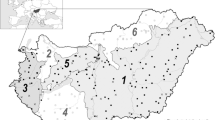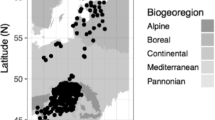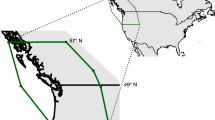Abstract
In this long-term study, we identify the climate variables most important to flowering density in Eriophorum latifolium in boreal rich fen vegetation, and assess their relative importance. We analysed time-series data (1982–2008) of flowering density in 126 permanent plots in an oceanic and a continental area in Norway, and developed an autoregressive model where the density of flowering plants was determined by the cost of previous flowering, climate during the same year as flowering, and climate during the year prior to flowering. The cost of reproduction was the most influential of the factors affecting flowering. Our results suggest that dry conditions during the previous summer affected flowering negatively in the oceanic population, but had no effect in the continental population. We attribute this to differences in hydrology, with steeply sloping fens in the oceanic area, and gently sloping, spring-fed fens in the continental area. Furthermore, flowering increased with the length of the previous growing season (oceanic population), decreased with the amount of precipitation during the previous spring (continental population), and increased with temperature in spring the same year (both populations). We conclude that climate conditions during the previous year are more important than climate conditions during the year of flowering.






Similar content being viewed by others
References
Aerts R, Cornelissen JHC, Dorrepaal E, van Logtestijn RSP, Callaghan TV (2004) Effects of experimentally imposed climate scenarios on flowering phenology and flower production of subarctic bog species. Global Change Biology 10:1599–1609. doi:10.1111/j.1365-2486.2004.00815.x
Aerts R, Cornelissen JHC, Dorrepaal E (2006) Plant performance in a warmer world: general responses of plants from cold, northern biomes and the importance of winter and spring events. Plant Ecology 182:65–77. doi:10.1007/s11258-005-9031-1
Aldridge G, Inouye DW, Forrest JRK, Barr WA, Miller-Rushing AJ (2011) Emergence of a mid-season period of low floral resources in a montane meadow ecosystem associated with climate change. Journal of Ecology 99:905–913. doi:10.1111/j.1365-2745.2011.01826
Ashman TL (1994) A dynamic perspective on the physiological cost of reproduction in plants. American Naturalist 144:300–316
Aydelotte AR, Diggle PK (1997) Analysis of developmental preformation in the alpine herb Caltha leptosepala (Ranunculaceae). American Journal of Botany 84:1646–1657. doi:10.2307/2446462
Bedford BL, Godwin KS (2003) Fens of the United States: distribution, characteristics, and scientific connection versus legal isolation. Wetlands 23:608–629. doi:10.1672/0277-5212(2003)023[0608:FOTUSD]2.0.CO;2
Bertin R (2008) Plant phenology and distribution in relation to recent climate change. The Journal of the Torrey Botanical Society 135:126–146. doi:10.3159/07-RP-035R.1
Blinova IV (2008) Populations of orchids at the northern limit of their distribution (Murmansk Oblast): effect of climate. Russian Journal of Ecology 39:26–33. doi:10.1134/s1067413608010050
Bloor JMG, Pichon P, Falcimagne R, Leadley P, Soussana JF (2010) Effects of warming, summer drought, and CO2 enrichment on aboveground biomass production, flowering phenology, and community structure in an upland grassland ecosystem. Ecosystems 13:888–900. doi:10.1007/s10021-010-9363-0
Bronson DR, Gower ST, Tanner M, Van Herk I (2009) Effect of ecosystem warming on boreal black spruce bud burst and shoot growth. Global Change Biology 15:1534–1543. doi:10.1111/j.1365-2486.2009.01845.x
Bullard ER, Shearer HDH, Day JD, Crawford RMM (1987) Survival and flowering of Primula scotica hook. Journal of Ecology 75:589–602. doi:10.2307/2260191
Calvo RN, Horvitz CC (1990) Pollinator limitation, cost of reproduction, and fitness in plants: a transition-matrix demographic approach. American Naturalist 136:499–516
Chapin FS, Shaver GR (1996) Physiological and growth responses of arctic plants to a field experiment simulating climatic change. Ecology 77:822–840
Crawford RMM (2000) Ecological hazards of oceanic environments. New Phytologist 147:257–281. doi:10.1046/j.1469-8137.2000.00705.x
Crawley MJ (1997) Life history and environment. In: Crawley MJ (ed) Plant ecology, 2nd edn. Blackwell Science Ltd., Oxford, pp 73–131
Crawley MJ (2007) The R Book. John Wiley & Sons Ltd, Chichester
de Vere N (2007) Biological Flora of the British Isles: Cirsium dissectum (L.) Hill (Cirsium tuberosum (L.) All. subsp anglicum (Lam.) Bonnier; Cnicus pratensis (Huds.) Willd., non Lam.; Cirsium anglicum (Lam.) DC.). Journal of Ecology 95:876–894. doi:10.1111/j.1365-2745.2007.01265.x
Ehrlén J, Eriksson O (1995) Pollen limitation and population growth in a herbaceous perennial legume. Ecology 76:652–656
Ejankowski W (2008) Effect of waterlogging on regeneration in the dwarf birch (Betula nana). Biologia 63:670–676. doi:10.2478/s11756-008-0126-8
Essl F, Dullinger S, Moser D, Rabitsch W, Kleinbauer I (2012) Vulnerability of mires under climate change: implications for nature conservation and climate change adaptation. Biodiversity and Conservation 21:655–669
Fernández-Pascual E, Jiménez-Alfaro B, Hájek M, Díaz TE, Pritchard HW (2015) Soil thermal buffer and regeneration niche may favour calcareous fen resilience to climate change. Folia Geobotanica 50:293–301
Field CB, Barros V, Stocker TF, Qin D, Dokken DJ, Ebi KL, Mastrandrea MD, Mach KJ, Plattner G-K, Allen SK, Tignor M, Midgley PM (eds) (2012) Managing the risks of extreme events and disasters to advance climate change adaptation. A Special Report of Working Groups I and II of the Intergovernmental Panel on Climate Change. Cambridge University Press, Cambridge
Fox LR, Ribeiro SP, Brown VK, Masters GJ, Clarke IP (1999) Direct and indirect effects of climate change on St John’s wort, Hypericum perforatum L. (Hypericaceae). Oecologia 120:113–122. doi:10.1007/s004420050839
Gong J, Wang K, Kellomäki S, Zhang C, Martikainen PJ, Shurpali N (2012) Modeling water table changes in boreal peatlands of Finland under changing climate conditions. Ecological Modelling 244:65–78. doi:10.1016/j.ecolmodel.2012.06.031
Grace J (1997) Plant water relations. In: Crawley MJ (ed) Plant ecology, 2nd edn. Blackwell Science Ltd., Oxford, pp 28–50
Grime JP (2001) Plant strategies, vegetation processes, and ecosystem properties, 2nd edn. John Wiley & Sons Ltd, Chichester
Hájek M, Horsák M, Hájková P, Dítě D (2006) Habitat diversity of central European fens in relation to environmental gradients and an effort to standardise fen terminology in ecological studies. Perspectives in Plant Ecology, Evolution and Systematics 8:97–114. doi:10.1016/j.ppees.2006.08.002
Havas P (1961) Vegetation und Ökologie der ostfinnischen Hangmoore. Annales Botanici Societatis Vanamo 31:1–188
Heide OM (1994) Control of flowering and reproduction in temperate grasses. New Phytologist 128:347–362. doi:10.1111/j.1469-8137.1994.tb04019.x
Heide OM (2002) Climatic flowering requirements of bipolar sedges Carex spp. and the feasibility of their trans-equatorial migration by mountain-hopping. Oikos 99:352–362. doi:10.1034/j.1600-0706.2002.990217.x
Holway JG, Ward RT (1965) Phenology of alpine plants in Northern Colorado. Ecology 46:73–83. doi:10.2307/1935259
Hudson JMG, Henry GHR (2009) Increased plant biomass in a High Arctic heath community from 1981 to 2008. Ecology 90:2657–2663. doi:10.1890/09-0102.1
Hughes L (2000) Biological consequences of global warming: is the signal already apparent? Trends in Ecology & Evolution 15:56–61. doi:10.1016/S0169-5347(99)01764-4
Inghe O, Tamm CO (1985) Survival and flowering of perennial herbs. IV. The behavior of Hepatica nobilis and Sanicula europaea on permanent plots during 1943–1981. Oikos 45:400–420. doi:10.2307/3565576
Inghe O, Tamm CO (1988) Survival and flowering of perennial herbs. V. Patterns of flowering. Oikos 51:203–219. doi:10.2307/3565644
Inouye DW, Morales MA, Dodge GJ (2002) Variation in timing and abundance of flowering by Delphinium barbeyi Huth (Ranunculaceae): the roles of snowpack, frost, and La Niña, in the context of climate change. Oecologia 130:543–550. doi:10.1007/s00442-001-0835-y
Janečková P, Wotavová K, Schödelbauerová I, Jersáková J, Kindlmann P (2006) Relative effects of management and environmental conditions and performance and survival of populations of a terrestrial orchid, Dactylorhiza majalis. Biological Conservation 129:40–49
Jentsch A, Kreyling J, Elmer M, Gellesch E, Glaser B, Grant K, Hein R, Lara M, Mirzae H, Nadler SE, Nagy L, Otieno D, Pritsch K, Rascher U, Schädler M, Schloter M, Singh BK, Stadler J, Walter J, Wellstein C, Wöllecke J, Beierkuhnlein C (2011) Climate extremes initiate ecosystem-regulating functions while maintaining productivity. Journal of Ecology 99:689–702. doi:10.1111/j.1365-2745.2011.01817.x
Jiménez-Alfaro B, Hájek M, Ejrnaes R, Rodwell J, Pawlikowski P, Weeda EJ, Laitinen J, Moen A, Bergamini A, Aunina L, Sekulová L, Tahvanainen T, Gillet F, Jandt U, Dítě D, Hájková P, Corriol G, Kondelin H, Díaz TE (2014) Biogeographic patterns of base-rich fen vegetation across Europe. Applied Vegetation Science 17:367–380. doi:10.1111/avsc.12065
Jongejans E, de Kroon H, Berendse F (2006) The interplay between shifts in biomass allocation and costs of reproduction in four grassland perennials under simulated successional change. Oecologia 147:369–378. doi:10.1007/s00442-005-0325-8
Jónsdóttir IS, Watson MA (1997) Extensive physiological integration: an adaptive trait in resource-poor environments? In: de Kroon H, van Groenendael J (eds) The ecology and evolution of clonal plants. Backhuys Publishers, Leiden, pp 109–136
Joosten H, Moen A, Tanneberger F (eds) (2016) Mires and peatlands of Europe: status, distribution and nature conservation. Schweizerbart Science Publisher, Stuttgart
Laaksonen K (1979) Effective temperature sums and durations of the vegetative period in Fennoscandia (1920–1950). Fennia 157:171–197
Lund M, Lafleur PM, Roulet NT, Lindroth A, Christensen TR, Aurela M, Chojnicki BH, Flanagan LB, Humphreys ER, Laurila T, Oechel WC, Olejnik J, Rinne J, Schubert P, Nilsson MB (2010) Variability in exchange of CO2 across 12 northern peatland and tundra sites. Global Change Biology 16:2436–2448
Matthes H, Rinke A, Dethloff K (2009) Variability of observed temperature-derived climate indices in the Arctic. Global and Planetary Change 69:214–224. doi:10.1016/j.gloplacha.2009.10.004
McCulloch CE, Searle SR (2001) Generalized, linear, and mixed models. Wiley series in probability and statistics. Wiley, New York
Meineri E, Skarpaas O, Spindelböck J, Bargmann T, Vandvik V (2014) Direct and size-dependent effects of climate on flowering performance in alpine and lowland herbaceous species. Journal of Vegetation Science 25:275–286
Menzel A, Sparks TH, Estrella N, Koch E, Aasa A, Ahas R, Alm-Kübler K, Bissolli P, Braslavská O, Briede A, Chmielewski FM, Crepinsek Z, Curnel Y, Dahl Å, Defila C, Donnelly A, Filella Y, Jatczak K, Måge F, Mestre A, Nordli Ø, Peñuelas J, Pirinen P, Remišová V, Scheifinger H, Striz M, Susnik A, van Vliet AJH, Wielgolaski FE, Zach S, Zust A (2006) European phenological response to climate change matches the warming pattern. Global Change Biology 12:1969–1976
Metsävainio K (1931) Untersuchungen über das Wurzelsystem der Moorpflanzen. Annales Botanici Societatis Vanamo 1:1–418
Moen A (1990) The plant cover of the boreal uplands of Central Norway. I. Vegetation ecology of Sølendet nature reserve; haymaking fens and birch woodlands. Gunneria 63:1–451
Moen A (1999) National Atlas of Norway: vegetation. National Atlas of Norway. Norwegian Mapping Authority, Hønefoss
Moen A (2000) Botanical mapping and management plan for Tågdalen Nature Reserve in Surnadal, Central Norway. NTNU Vitenskapsmuseet Rapport Botanisk Serie 2000–7:1–45
Moen A, Øien D-I (2003) Ecology and survival of Nigritella nigra, a threatened orchid species in Scandinavia. Nordic Journal of Botany 22:435–461
Moen A, Lyngstad A, Øien D-I (2012) Boreal rich fen vegetation formerly used for haymaking. Nordic Journal of Botany 30:226–240. doi:10.1111/j.1756-1051.2011.01253.x
Moen A, Lyngstad A, Øien D-I (2015) Hay crop of boreal rich fen communities traditionally used for haymaking. Folia Geobotanica 50:25–38. doi:10.1007/s12224-015-9204-1
Obeso JR (2002) The costs of reproduction in plants. New Phytologist 155:321–348
Øien D-I, Moen A (2002) Flowering and survival of Dactylorhiza lapponica and Gymnadenia conopsea in the Sølendet Nature Reserve, Central Norway. In: Kindlmann P, Willems JH, Whigham DF (eds) Trends and fluctuations and underlying mechanisms in terrestrial orchid populations. Backhuys Publishers, Leiden, pp 3–22
Øien D-I, Pedersen B (2005) Seasonal pattern of dry matter allocation in Dactylorhiza lapponica (Orchidaceae) and the relation between tuber size and flowering. Nordic Journal of Botany 23:441–451. doi:10.1111/j.1756-1051.2003.tb00418.x
Parviainen M, Luoto M (2007) Climate envelopes of mire complex types in Fennoscandia. Geografiska Annaler: Series A, Physical Geography 89A:137–151
Peñuelas J, Gordon C, Llorens L, Nielsen T, Tietema A, Beier C, Bruna P, Emmett B, Estiarte M, Gorissen A (2004) Nonintrusive field experiments show different plant responses to warming and drought among sites, seasons, and species in a north-south European gradient. Ecosystems 7:598–612. doi:10.1007/s10021-004-0179-7
Persson Å (1961) Mire and spring vegetation in an area north of Lake Torneträsk, Torne Lappmark, Sweden. I. Description of the vegetation. Opera Botanica 6:1–187
Persson Å (1962) Mire and spring vegetation in an area north of Lake Torneträsk, Torne Lappmark, Sweden. II. Habitat conditions. Opera Botanica 6:1–100
Primack R, Stacy E (1998) Cost of reproduction in the pink lady’s slipper orchid, (Cypripedium acaule, Orchidaceae): an eleven-year experimental study of three populations. American Journal of Botany 85:1672–1679
Raunkiær C (1895) De danske blomsterplanters naturhistorie. I. Enkimbladede. Gyldendalske Boghandels Forlag, København
Rydin H, Jeglum JK (2013) The biology of peatlands, 2nd edn. Oxford University Press, Oxford
Saavedra F, Inouye DW, Price MV, Harte J (2003) Changes in flowering and abundance of Delphinium nuttallianum (Ranunculaceae) in response to a subalpine climate warming experiment. Global Change Biology 9:885–894. doi:10.1046/j.1365-2486.2003.00635.x
Sandvik SM, Heegaard E, Elven R, Vandvik V (2004) Responses of alpine snowbed vegetation to long-term experimental warming. Ecoscience 11:150–159
Sjörs H (1948) Myrvegetation i Bergslagen. Acta Phytogeogrica Suecica 21:1–299
Sjörs H (1952) On the relation between vegetation and electrolytes in north Swedish mire waters. Oikos 2(1950):241–258
Sletvold N, Øien D-I, Moen A (2010) Long-term influence of mowing on population dynamics in the rare orchid Dactylorhiza lapponica: the importance of recruitment and seed production. Biological Conservation 143:747–755
Sletvold N, Dahlgren JP, Øien D-I, Moen A, Ehrlen J (2013) Climatic conditions influence the effect of land use on the population viability of a rare orchid: a 30-year experimental study. Global Change Biology 19:2729–2738
Syrjänen K, Lehtilä K (1993) The cost of reproduction in Primula veris: differences between two adjacent populations. Oikos 67:465–472. doi:10.2307/3545358
ter Braak CJF, Looman CWN (1995) Regression. In: Jongman RHG, ter Braak CJF, van Tongeren OFR (eds) Data analysis in community and landscape ecology. Cambridge University Press, Cambridge, pp 29–77
The BACC Author Team (2008) Past and Current Climate Change. In: Assessment of climate change for the Baltic Sea Basin. Regional climate studies. Springer, Berlin, pp 35–131
Tveito OE, Bjørdal I, Skjelvåg A, Aune B (2005) A GIS-based agro-ecological decision system based on gridded climatology. Meteorological Applications 12:57–68. doi:10.1017/S1350482705001490
Woodward FI (1990) The impact of low-temperatures in controlling the geographical distribution of plants. Philosophical Transactions of the Royal Society of London B: Biological Sciences 326:585–593. doi:10.1098/rstb.1990.0033
Zhaojun B, Joosten H, Hongkai L, Gaolin Z, Xingxing Z, Jinze M, Jing Z (2011) The response of peatlands to climate warming: a review. Acta Ecologica Sinica 31:157–162. doi:10.1016/j.chnaes.2011.03.006
Zuur AF, Ieno EN, Walker NJ, Saveliev AA, Smith GM (2009) Mixed effects models and extensions in ecology with R. Springer, New York
Acknowledgements
Many have contributed to the collection of the data used in this paper, and we mention Dag-Inge Øien especially. We would also like to thank Håkan Rydin, Kristian Hassel and three anonymous reviewers for comments and suggestions. This study is part of a PhD project that was funded by the Norwegian University of Science and Technology. The paper is a contribution to the research project “Mires and Climate” in the Polish-Norwegian research programme.
Author information
Authors and Affiliations
Corresponding author
Electronic supplementary material
Below is the link to the electronic supplementary material.
Online Resource 1
(DOC 127 kb)
Online Resource 2
(DOC 114 kb)
Online Resource 3
(DOC 67 kb)
Rights and permissions
About this article
Cite this article
Lyngstad, A., Moen, A. & Pedersen, B. Flowering in the Rich Fen Species Eriophorum latifolium Depends on Climate and Reproduction in the Previous Year. Wetlands 37, 1–13 (2017). https://doi.org/10.1007/s13157-016-0794-z
Received:
Accepted:
Published:
Issue Date:
DOI: https://doi.org/10.1007/s13157-016-0794-z




